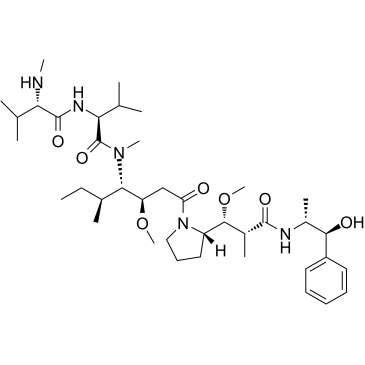| DC57041 |
N-Me-L-Ala-maytansinol
|
N-Me-L-Ala-maytansinol is a maytansine derivative. .N-Me-L-Ala-maytansinol can be used for synthesis of antibody-drug conjugate (ADC). |
| DC28020 |
Maytansine
|
Maytansine, a benzoansamacrolide, is a highly potent microtubule-targeted compound that induces mitotic arrest and kills tumor cells at subnanomolar concentrations. However, it failed as an anticancer agent in human clinical trials because of lack of tumo |
| DC7021 |
Monomethyl auristatin E (vedotin)
|
Monomethyl auristatin E (MMAE; Vedotin) is a hot topic in Antibody-drug conjugates (ADCs) studies. It is an antimitotic agent which inhibits cell division by blocking the polymerisation of tubulin. |
| DC11275 |
Calicheamicin
|
Calicheamicin, also known as Calicheamicin gamma(1,I) or Calichemicin gamma1, is an potent enediyne antitumor antibiotics derived from the bacterium Micromonospora echinospora. Calicheamicin targets DNA and cause strand scission. Calicheamicin binds with DNA in the minor groove, wherein it then undergos a reaction analogous to the Bergman cyclization to generate a diradical species. This diradical, 1,4-didehydrobenzene, then abstracts hydrogen atoms from the deoxyribose (sugar) backbone of DNA, which ultimately leads to strand scission. The specificity of binding of calicheamicin to the minor groove of DNA is due to the aryltetrasaccharide group of the molecule. |
| DC8802 |
Maytansinol(Ansamitocin P-0)
|
Maytansinol inhibits microtubule assembly and induces microtubule disassembly in vitro. Target: Microtubule/Tubulin in vitro: Maytansinol disrupts the mitotic spindle and prevents mitotic exit in Drosophila. Maytansinol reduces the growth and/or survival of HCT116 cells in a dose-dependent manner and that the effect was more severe for p53+/+ than for p53-/- cells at both low and high doses. Maytansinol inhibits the growth of HCT116 human colon cancer cells. Maytansinol induces apoptosis in imaginal discs of wild-type larvae but not p53 mutant larvae. This parallels the finding in human HCT116 cells, in which Maytansinol was more effective when p53 was present, at least at some doses. Maytansinol induces apoptosis in imaginal discs of wild-type larvae but not p53 mutant larvae at 24 hours after exposure to drug. |






















